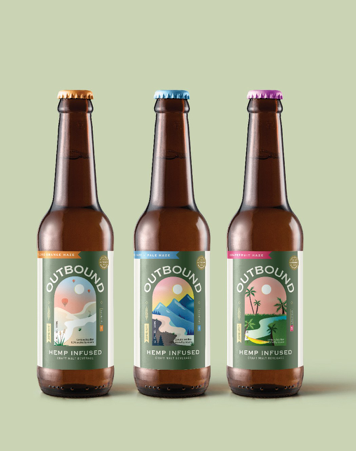This Bud’s For You
Can the marriage of hemp and hops be saved?
Discussions about cannabis-infused beers often begin with a lengthy disquisition on the shared botanical roots of both substances’ parent plants. This makes total sense. Twenty-seven million years ago, hops and cannabis split from a common resinous ancestor to fuel separate cultures of sedation, all while both retaining the curiously similar oily terpenes that true aficionados can parse in Talmudic detail: cedar, Mandarin orange, Pepe Le Pew, lemony-lime. A more direct discussion might be: Why reunite cannabis and beer in the first place? I understand how one can savor a joint and a double IPA together; getting all academic on the flavor profiles or the ins-and-outs of a particular high is stimulating indeed.
Still, it never quite occurred to me to meld the two complementary experiences into one quaffable pint. Double the pleasure, or double the trouble? And yet, beer companies big and small see a market waiting to explode. Anheuser-Busch, Heineken, Corona, and Molson Coors have all invested billions in cannabis shares (Corona parent Constellation Brands tops them all with a nearly $4 billion stake). So far, though, only one of the majors has actually brought a product to market: Heineken-owned Lagunitas sells Hi-Fi Hops in California and Colorado, in 5:5 CBD/THC, 10 mg THC, and 18 mg CBD varieties.

But here’s the thing: Lagunitas labels Hi-Fi as a “hoppy sparkling water.” It isn’t really a beer, and the company says it isn’t trying too hard to create a true-brew infusion. The reason why is both sad and irrefutable: The obvious choice to combine THC and alcoholic beer is actually illegal in every state. Which, for now, means that two great tastes that may go great together won’t be going together. Instead, two discreet forms are emerging when we’re talking about cannabis-infused beer: Alcoholic beer enhanced with CBD, and nonalcoholic beer infused with varying amounts of THC. Just getting your hands on a pint— even in a cannabis-friendly state—can be a chore. California and Colorado have the most permissive rules and therefore biggest selection; small brew- ers like Ceria Grainwave and Dads & Dudes in Colorado and Outbound in California offer craft options. In my first-wave weed state of Wash- ington, however, cannabis beers can’t be found in any form. Dang.
What’s an intrepid beverage journalist to do? I packed the Subaru and traveled south to Oregon in hopes of trying vaunted Coalition Brewing’s Two Flowers IPA, a CBD blend…only to discover upon arrival that I’d just missed out. After scouring stores and breweries to try it, I discovered Coalition had just closed, selling out to another brewer who had no plans to continue Coalition’s hempy experiments.
A budtender in Colorado I reached out to—he asked that his name be withheld—said his dispensary stocked a few varieties but discontinued them after realizing they “tasted terrible.” (He declined to mention brand names.) “Why not just buy a regular Colorado IPA?” he said, bewildered.
In Oregon, I seriously considered continuing south to California, but that’s probably foolish—especially since I could technically stop into BevMo and then a dispensary to perform a few experiments myself. Instead, I’m starting to feel like cannabis-infused beers aren’t quite ready for their closeup—or at least, it’s an idea from the future that hasn’t found a hazy constituency yet. So far, libations just aren’t how Americans like to get high: Infused beverages make up a scant 2% of cannabis industry sales.
“Consumer education is a huge hurdle,” says Lyden Henderson, COO and co-founder of Outbound Brewing, a San Diego craft beer maker. “There has been a lot of misunderstanding in consumption. People are uncertain about the difference between an edible and a drinkable. From a marketing perspective, we’re running into a lot of confusion around drinkables; a lot of people want to equate it to edibles. But we think we’re onto something really special with the fast-acting nature of our beers: The effect starts subliminally after only 15-30 minutes—it’s actually a lot more like drinking a regular beer.” Outbound is non-alcoholic and comes in three styles—a Hefeweizen, pale ale, and blonde ale—all with 10mg THC per 12-ounce bottle. Henderson believes the familiar time-to-buzz will pave the way for adoption. “This has huge implications for self-regulation and comfortability,” he says.
Related: Chill Out With CBD-Infused Drinks
If infused non-alcoholic beers gain greater acceptance, credit the kids. Recent studies have shown declines in alcohol use among Millennials and an uptick in “sober-curious” and wellness-focused lifestyles. It’s here that large beer brands might be making a canny bet: After seeing craft breweries and now youth-culture teetotaling eating into their bottom line, a hedge into hash drinks could pay off in the long run.
“I see beers like ours being one of the things that get people into trying cannabis,” Henderson says. “People are comfortable with an adult beverage, they’re used to beer in social situations, children are familiar with adult beverages as off-limits, and it’s also going to allow people to try it if they’ve never smoked anything. It gets you past the stigma. As education around cannabis education becomes ubiquitous, we’re going to see huge increases.”
Even if alcohol falls from favor, social escapism never will: Squint just a bit and you can easily imagine a tasting room full of low-calorie, head-high-forward cannabis beverages that open up a new kind of social drinking dynamic. Instead of pass the joint, it’s pass the pitcher. It might not happen until legalization goes national, but when it does beer will be the bridge to bring fogeys like me along, finally blending the best of both worlds. At least then I won’t have to work so hard to find it.